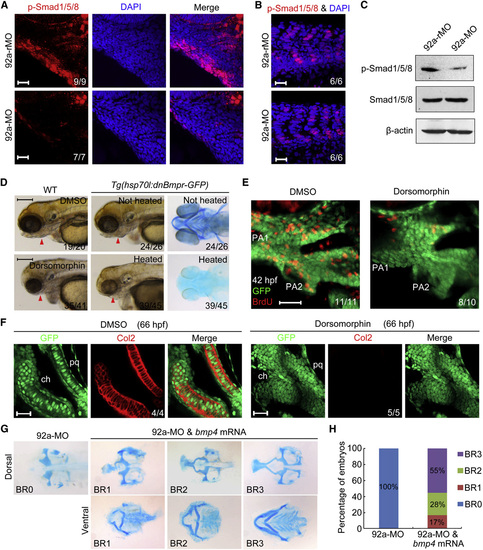Fig. 4
- ID
- ZDB-FIG-140522-35
- Publication
- Ning et al., 2013 - MicroRNA-92a upholds Bmp signaling by targeting noggin3 during pharyngeal cartilage formation
- Other Figures
- All Figure Page
- Back to All Figure Page
|
mir92a Regulates Bmp Signaling during Pharyngeal Cartilage Formation (A–C) p-Smad1/5/8 levels were reduced in the pharyngeal region of mir92a morphants. 92a-rMO and 92a-MO-injected (4 ng) Tg(fli1:EGFP) embryos at 42 hpf were stained for p-Smad1/5/8 using anti-p-smad1/5/8 and DAPI (A, B). The pharyngeal region (A) and trunk somite muscle (B) were observed after immunostaining by confocal microscopy. p-Smad1/5/8 in cell lysis of head region at 42 hpf was detected by western blotting (C). Scale bars, 20 µm. (D) Embryos depleted of Bmp activity showed severe pharyngeal cartilage defects. Dorsomorphin-treated wild-type (WT) or heat-shocked Tg(hsp70l:dnBmpr-GFP) transgenic live embryos were photographed at 96 hpf and Pharyngeal cartilages of heat-shocked transgenic embryos at 80 hpf were detected with Alcian blue. Scale bars, 200 µm. (E) Embryos depleted of Bmp activity showed a reduced proliferation of pharyngeal chondrogenic progenitors. BrdU-treated Tg(fli1:EGFP) transgenic embryos were stained at 42 hpf with anti-BrdU (red) and anti-GFP antibodies (green). The pharyngeal regions were observed by confocal microscopy. Scale bar, 20 µm. (F) Deficiency of pharyngeal chondrogenic progenitor differentiation in dorsomorphin-treated embryos. Confocal sections of the palatoquadrate (pq) and ceratohyal (ch) cartilages of Tg(fli1:EGFP) transgenic embryos. These embryos were treated with DMSO or 10 µM dorsomorphin at 36 hpf and probed with anti-GFP and anti-Col2 antibodies at 66 hpf. Scale bars, 20 µm. (G and H) 92a-MO-induced pharyngeal cartilage defects were rescued by bmp4 overexpression. Wild-type embryos were injected with 4 ng 92a-MO alone or together with 7 pg bmp4 mRNA at the one-cell stage and stained with Alcian blue for cartilages at 80 hpf. Coinjected embryos showed different levels of recovery of neurocranium and pharyngeal cartilages. Representative cartilage phenotypes (BR0-BR3) were shown in (G) and their ratios were shown in (H). See also Fig. S4. |
| Gene: | |
|---|---|
| Antibodies: | |
| Fish: | |
| Condition: | |
| Knockdown Reagent: | |
| Anatomical Terms: | |
| Stage Range: | High-pec to Pec-fin |
| Fish: | |
|---|---|
| Conditions: | |
| Observed In: | |
| Stage Range: | High-pec to Day 4 |
Reprinted from Developmental Cell, 24(3), Ning, G., Liu, X., Dai, M., Meng, A., and Wang, Q., MicroRNA-92a upholds Bmp signaling by targeting noggin3 during pharyngeal cartilage formation, 283-295, Copyright (2013) with permission from Elsevier. Full text @ Dev. Cell

